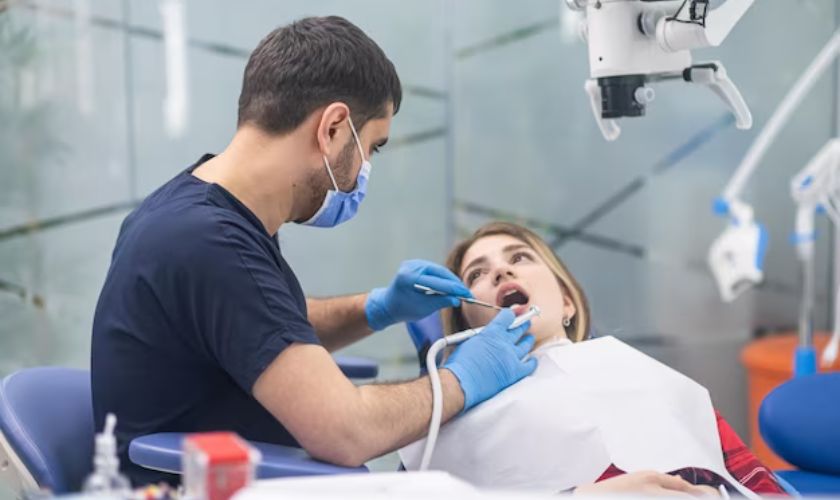
Step-By-Step Sedation Dentistry Process: What To Expect
Are you one of those people who break out in a cold sweat at the mere thought of visiting the dentist? If so, you’re not alone. Dental anxiety is a common issue that affects millions of individuals worldwide. The good news is that sedation dentistry can help alleviate your fears and make your dental experience much more comfortable and stress-free. In this blog post, we’ll take you through the step-by-step process of sedation dentistry, from understanding the different types of sedation to preparing for your appointment. So sit back, relax, and dive into the world of sedation dentistry!
The Different Types Of Sedation
When it comes to sedation dentistry, several different types of sedation can be used depending on your level of anxiety and the nature of the dental procedure.
Nitrous Oxide Or Laughing Gas: One common type is nitrous oxide, or “laughing gas.” This mild form of sedation is inhaled through a mask and helps you feel relaxed and at ease during dental treatment. It wears off quickly, allowing you to resume normal activities without lingering drowsiness.
Oral sedatives may be prescribed for those with moderate to severe dental anxiety. These medications are taken before your appointment and help calm your nerves. They induce a state of relaxation while still allowing you to remain conscious throughout the procedure.
Oral sedatives: Oral sedatives may be prescribed for those with moderate to severe dental anxiety. These medications are taken before your appointment and help calm your nerves. They induce a state of relaxation while still allowing you to remain conscious throughout the procedure.
Intravenous (IV) sedation: Intravenous (IV) sedation is another option for individuals who require a deeper level of relaxation. Administered intravenously by a trained professional, this type of sedation induces a sleep-like state where you’ll have little or no memory of the procedure
General anesthesia: General anesthesia is reserved for complex dental surgeries or cases involving extreme fear or special needs patients. Under general anesthesia, you will be completely unconscious during the procedure. Remember that each type of sedation has benefits and risks, so it’s important to discuss with your dentist which option best suits your needs.
What Are The Benefits Of Sedation Dentistry?
Sedation dentistry offers numerous benefits for patients who experience dental anxiety or have a low pain threshold. One of the main advantages is that it helps create a more relaxed and comfortable dental experience. Patients can feel at ease during their dental procedures by using sedation techniques, such as oral medication or IV sedation.
Another benefit of sedation dentistry is allowing the dentist to complete multiple treatments in one visit. This means fewer appointments and less time spent in the dental chair overall. This can be a significant advantage for individuals with busy schedules or limited availability.
Additionally, sedation dentistry enables patients to undergo complex procedures without discomfort. Whether it’s a root canal, wisdom tooth extraction, or implant placement, sedation ensures you remain calm and pain-free.
Furthermore, sedation can help alleviate any traumatic memories associated with previous painful dental experiences. It allows patients to overcome their fears and regain trust in their dentist.
The benefits of sedation dentistry are undeniable. It reduces anxiety levels and allows efficient treatment completion within fewer visits while ensuring comfort during complex procedures. These advantages make it attractive for individuals seeking a stress-free and pleasant dental experience.
How To Prepare For Your Sedation Dentistry Appointment
Preparing for your sedation dentistry appointment is an important step to ensure a smooth and comfortable experience. Here are some key tips to help you get ready:
1. Consultation With The Dentist: Before scheduling your sedation dentistry appointment, it’s crucial to have a consultation with your dentist. Discuss any concerns or medical conditions affecting the sedation process during this meeting.
2. Follow Pre-Operative Instructions: Your dentist will provide specific guidelines on what you should do before the procedure. This may include fasting for a certain period or avoiding certain medications.
3. Arrange Transportation: Sedation can leave you feeling drowsy or disoriented, so it’s essential to arrange for someone to drive you home after the appointment.
4. Dress Comfortably: Opt for loose-fitting clothing that allows easy access to your arms and upper body, as dental procedures often require various instruments and equipment.
5. Communication Is Key: Communicate openly with your dentist about any fears or anxieties you may have leading up to the appointment.
Remember, every person has unique needs when it comes to sedation dentistry preparation, so follow these general tips while also adhering closely to the guidance provided by your dental professional.
Sedation dentistry offers a safe and effective solution for individuals who experience anxiety or fear when visiting the dentist. By utilizing different types of sedation, such as nitrous oxide, oral sedatives, or IV sedation, dental professionals can help patients feel calm and relaxed during their procedures. Consider sedation dentistry if you have been putting off important dental care due to anxiety or fear. With its ability to provide relaxation and comfort throughout your visit, it could be just what you need to achieve optimal oral health without unnecessary stress.
So why let fear keep you from getting the dental care you deserve? Talk to your dentist today about how sedation dentistry can transform your dental experience into a positive one – because everyone deserves a healthy smile!
